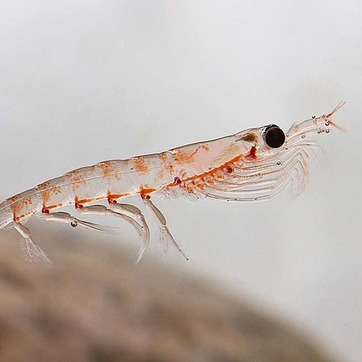Krill plays a key role in the Antarctic ecosystem. It is the almost inexhaustible source of food in the cold waters of Antarctica. Whales, penguins, seabirds, seals and also swarms of fish such as herring, mackerel and tuna feed on Antarctic krill. The very appropriate name “krill” comes from Norway and means something like “whale soup” – about five million specimens of the crustacean were found in the stomach of a whale.

The Antarctic krill belongs to the krill family and is the largest and most common species of this group of crustaceans. The krill grows up to 6 cm in size and weighs between 1 and 2 grams when fully grown. For its size, the Antarctic krill can live to a ripe old age of up to 6 years.
These shrimp-shaped crustaceans belong to the swarm animals. The krill's luminosity seems to play a major role in the formation of swarms. The krill is equipped with 10 light organs on the body, which emit a bluish light. Due to the krill's large and powerful eyes, the neighbour's flashes of light can be perceived very well. If a krill has drifted away from the swarm, it only has to orientate itself by the lightning flashes of its fellow krill.
Since it would otherwise sink to the bottom, the krill is constantly in motion. When the animals flee predators, they can move an incredible 60 cm per second in reverse.
Algae and plankton – the krill's menu
The Antarctic krill is primarily a herbivore. In the summer months, it feeds on algae floating in the water in the Antarctic Ocean.
In winter, it is also difficult for the krill to find food. It then predominantly consumes ice algae, which it finds on the underside of pack ice. In addition, it is now assumed that even the smallest plankton is on the krill's menu.
Studies show that krill can rely on its own body's energy stores because it can survive for up to 200 days without food. With low food intake, the body of the krill shrinks, but the size of the eyes stays the same. This way you can quickly see the krill’s degree of nutrition. The shrimp-shaped krill is so valued today because it grows in very clean, low-pollution water and is at the bottom of the food chain.
By feeding on microalgae, krill absorb valuable omega-3 fatty acids in unadulterated purity.
Huge krill swarms
A krill rarely comes alone: they live in huge swarms that can stretch for several kilometres. As soon as they appear on the surface, their predators such as seabirds or baleen whales attack them – a natural spectacle.
During the summer months, large swarms can make the icy waters of Antarctica appear red due to their distinctive colouration. The red colouration of the animals is due to the valuable carotenoid astaxanthin. The krill consumes the dye astaxanthin in high concentrations through its food.
The reason for the enormously large swarms is that the Antarctic waters represent one of the largest concentration areas for plankton, the krill's main food. With around 500 million tonnes of biomass, krill is the most abundant animal species on earth.
Only about 0.03% of this incredible number of krill may be caught annually. This ensures the conservation of the Antarctic krill.

